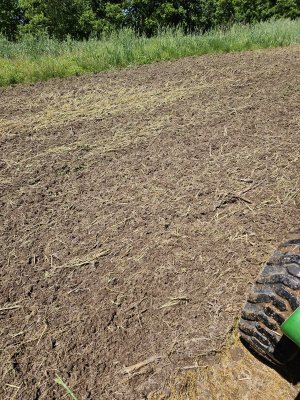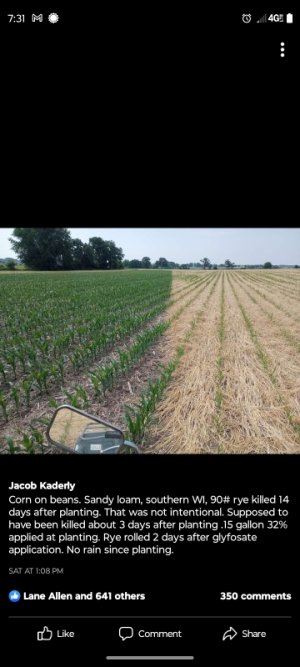That rye should act line a nice, natural weed barrier and should do well if you get enough rain to get the corn started. A number of the farmers in my area drill directly into cover crops and normally they do just fine. Last year was different though because of the drought and the no-tilled fields really struggled.
-
If you are posting pictures, and they aren't posting in the correct orientation, please flush your browser cache and try again.
Edge
Safari/iOS
Chrome
You are using an out of date browser. It may not display this or other websites correctly.
You should upgrade or use an alternative browser.
You should upgrade or use an alternative browser.
Spring weeds
- Thread starter Brian662
- Start date
omicron1792
5 year old buck +
Why not drill into duff without tilling?Update- mowed rye/crimson then sprayed. Tilling it up today, happy with the seed bed. My planter will do fine in this. Have to go a little slow with tiller but not bad.View attachment 64737
Brian662
5 year old buck +
Different property, different equipment. 2.5 hours apart.Why not drill into duff without tilling?
I have all the better equipment at home in MN where the bucks are smaller.
omicron1792
5 year old buck +
Ahh. Makes sense. You’ll get a great result tilling.
Brian662
5 year old buck +
Buddy we have both of those weeds up here and they aren't in short supply.Lucky you don't have marestail or pigweed,both gly resistant.I have to use enlist beans and spray interline along with gly to kill the weeds and grass.I use volunteer if just spraying grasses it's a generic cleth
S.T.Fanatic
5 year old buck +
I haven’t found a weed yet that I can’t smoke with gly.
Sent from my iPhone using Tapatalk
Sent from my iPhone using Tapatalk
T-Max
5 year old buck +
I haven’t found a weed yet that I can’t smoke with gly.
Sent from my iPhone using Tapatalk
Hang on to that. Cherish it. Tell it you love it and hope it never leaves you…
 Seriously though, you are fortunate.
Seriously though, you are fortunate.Sent from my iPhone using Tapatalk
Brian662
5 year old buck +
Follow up on the smashed rye and drilled corn. Corn looks to be doing good, 3-5" in height. Had one field where my drive chain snapped about 1/3 of the way in and missed a row of planting and fertilizing before realizing. Rye seems to be suppressing weeds. These fields have only seen one application of gly at the time I smashed rye. Going to put some pre emergent broadleaf down this week I think.
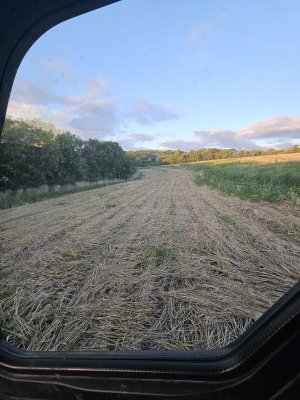

omicron1792
5 year old buck +
That looks great Brian
FarmerDan
5 year old buck +
Soil temperature differences - exposed dirt vs shaded? First thought comes into my mind. Classic till or no-till question. Could be something else. Rye allotropy?I’m really curious to see, but I’ve heard of guys seeing rye have an effect on corn early on. On another forum there was a picture of corn planted into rye and a bare field side by side. The corn in the rye looked like it was struggling. I think the consensus is that it always overcomes this so you should be fine. Just want to see your thoughts as it starts coming up.
Sent from my iPhone using Tapatalk
T-Max
5 year old buck +
FarmerDan
5 year old buck +
Interesting! It led me to do a little more reading. It's something I like to do - to explore. Anyhow, corn after rye seems to be a curious experience. I learned a lot from this, summary following:Not much context. I think folks were thinking allelopathy maybe?
Corn Following Cereal Rye Cover Crops: Research Sheds Light on Planting Green
Main Takeaways From the Research
- To maximize corn yields when planting after a cereal rye cover crop, avoid the potential negative influence of the cover crop on corn development. Negative influences include competition for moisture and nutrient resources and also the potential for cereal rye to act as a “green bridge” for pathogens that can infect corn seedlings.
- Don’t let the cover crop get too big: Do this by planting corn early in the spring (before 12-inches of growth or 750 heat units accumulate using a base temperature of 32 degrees Fahrenheit). Otherwise, terminate the cover crop and wait one to two weeks until it is brown and dead before planting corn.
- Increase the physical distance between the cover crop and the corn: Do this by leaving skip zones when seeding the cover crop in the fall or by using aggressive strip-tillage in the spring.
- Applying N fertilizer at planting is probably a good idea but our research can’t confirm that it will help to overcome yield drag from planting green into a cereal rye cover crop that is more than a foot tall.
SD51555
5 year old buck +
I've heard the opposite of that. I'm not married to either idea, but here's the alternate take on it.Interesting! It led me to do a little more reading. It's something I like to do - to explore. Anyhow, corn after rye seems to be a curious experience. I learned a lot from this, summary following:
Corn Following Cereal Rye Cover Crops: Research Sheds Light on Planting Green
Main Takeaways From the Research
- To maximize corn yields when planting after a cereal rye cover crop, avoid the potential negative influence of the cover crop on corn development. Negative influences include competition for moisture and nutrient resources and also the potential for cereal rye to act as a “green bridge” for pathogens that can infect corn seedlings.
- Don’t let the cover crop get too big: Do this by planting corn early in the spring (before 12-inches of growth or 750 heat units accumulate using a base temperature of 32 degrees Fahrenheit). Otherwise, terminate the cover crop and wait one to two weeks until it is brown and dead before planting corn.
- Increase the physical distance between the cover crop and the corn: Do this by leaving skip zones when seeding the cover crop in the fall or by using aggressive strip-tillage in the spring.
- Applying N fertilizer at planting is probably a good idea but our research can’t confirm that it will help to overcome yield drag from planting green into a cereal rye cover crop that is more than a foot tall.
One no-tiller (I think it was Dave Brandt) was talking about planting into heavy rye and perhaps hairy vetch. His crop also showed a similar drag early on vs tillage corn. He made an interesting point when he said, "I don't combine my corn in June." His point was that the jump start the black dirt guys got, fizzled out later when their topsoil biology cooked or the water turned off. Corn nitrogen utilization doesn't really ramp up until 4-6 weeks after it's out of the ground. By then, I imagine a lot of the tie up has subsided and the other benefits of retained moisture, cooler soil, and higher biological activity kick in.
Brian662
5 year old buck +
Fwiw, the farmers around here spray their rye when it's 8" or less but idk if that's before or after planting.
I fell behind on my spring plantings and didn't think the extra biomass and nitrogen from the crimson would be a problem. Whether the corn does 150 or 200 bushel, it doesn't matter to me. Ultimately if the deer are fed and the soil is a little healthier from the OM of the rye/crimson then I'm happy.
I fell behind on my spring plantings and didn't think the extra biomass and nitrogen from the crimson would be a problem. Whether the corn does 150 or 200 bushel, it doesn't matter to me. Ultimately if the deer are fed and the soil is a little healthier from the OM of the rye/crimson then I'm happy.
Brian662
5 year old buck +
Update on my corn planting, everything is looking good and healthy. Will give it a shot of nitrogen before a rain in the next two weeks. I can't complain about the planting methods and the thatch has broken down in some spots more than others but remains very weed free all over.
If it wasnt for my planter drive chain malfunction it would be a nearly perfect planting for my liking.
These are 3 different locations, FYI.
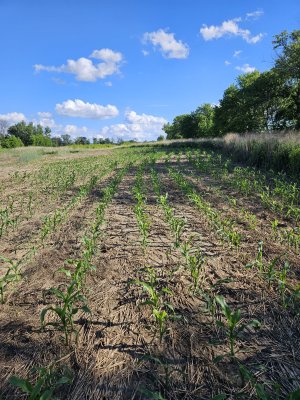
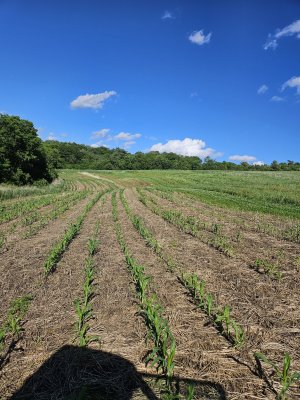
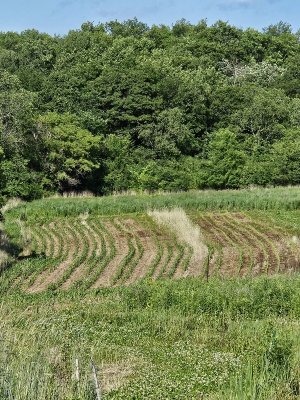
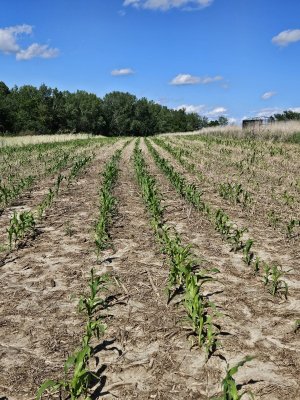
If it wasnt for my planter drive chain malfunction it would be a nearly perfect planting for my liking.
These are 3 different locations, FYI.




Similar threads
- Replies
- 21
- Views
- 1K

